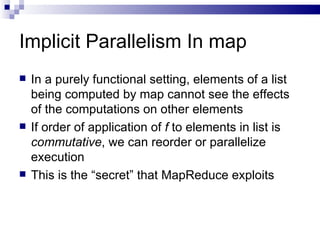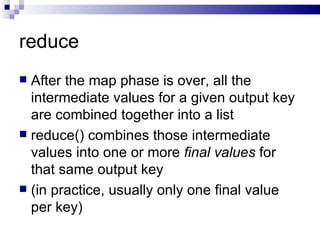Mapreduce: Theory and implementation
- 1. Lecture 2 – MapReduce: Theory and Implementation CSE 490h – Introduction to Distributed Computing, Spring 2007 Except as otherwise noted, the content of this presentation is licensed under the Creative Commons Attribution 2.5 License.
- 2. Outline Lisp/ML map/fold review MapReduce overview
- 3. Functional Programming Review Functional operations do not modify data structures: They always create new ones Original data still exists in unmodified form Data flows are implicit in program design Order of operations does not matter
- 4. Functional Programming Review fun foo(l: int list) = sum(l) + mul(l) + length(l) Order of sum() and mul(), etc does not matter – they do not modify l
- 5. Functional Updates Do Not Modify Structures fun append(x, lst) = let lst' = reverse lst in reverse ( x :: lst' ) The append() function above reverses a list, adds a new element to the front, and returns all of that, reversed, which appends an item. But it never modifies lst !
- 6. Functions Can Be Used As Arguments fun DoDouble(f, x) = f (f x) It does not matter what f does to its argument; DoDouble() will do it twice. What is the type of this function?
- 7. Map map f lst: (’a->’b) -> (’a list) -> (’b list) Creates a new list by applying f to each element of the input list; returns output in order.
- 8. Fold fold f x 0 lst: ('a*'b->'b)->'b->('a list)->'b Moves across a list, applying f to each element plus an accumulator . f returns the next accumulator value, which is combined with the next element of the list
- 9. fold left vs. fold right Order of list elements can be significant Fold left moves left-to-right across the list Fold right moves from right-to-left SML Implementation: fun foldl f a [] = a | foldl f a (x::xs) = foldl f (f(x, a)) xs fun foldr f a [] = a | foldr f a (x::xs) = f(x, (foldr f a xs))
- 10. Example fun foo(l: int list) = sum(l) + mul(l) + length(l) How can we implement this?
- 11. Example (Solved) fun foo(l: int list) = sum(l) + mul(l) + length(l) fun sum(lst) = foldl (fn (x,a)=>x+a) 0 lst fun mul(lst) = foldl (fn (x,a)=>x*a) 1 lst fun length(lst) = foldl (fn (x,a)=>1+a) 0 lst
- 12. A More Complicated Fold Problem Given a list of numbers, how can we generate a list of partial sums? e.g.: [1, 4, 8, 3, 7, 9] [0, 1, 5, 13, 16, 23, 32]
- 13. A More Complicated Map Problem Given a list of words, can we: reverse the letters in each word, and reverse the whole list, so it all comes out backwards? [“my”, “happy”, “cat”] -> [“tac”, “yppah”, “ym”]
- 14. map Implementation This implementation moves left-to-right across the list, mapping elements one at a time … But does it need to? fun map f [] = [] | map f (x::xs) = (f x) :: (map f xs)
- 15. Implicit Parallelism In map In a purely functional setting, elements of a list being computed by map cannot see the effects of the computations on other elements If order of application of f to elements in list is commutative , we can reorder or parallelize execution This is the “secret” that MapReduce exploits
- 16. MapReduce
- 17. Motivation: Large Scale Data Processing Want to process lots of data ( > 1 TB) Want to parallelize across hundreds/thousands of CPUs … Want to make this easy
- 18. MapReduce Automatic parallelization & distribution Fault-tolerant Provides status and monitoring tools Clean abstraction for programmers
- 19. Programming Model Borrows from functional programming Users implement interface of two functions: map (in_key, in_value) -> (out_key, intermediate_value) list reduce (out_key, intermediate_value list) -> out_value list
- 20. map Records from the data source (lines out of files, rows of a database, etc) are fed into the map function as key*value pairs: e.g., (filename, line). map() produces one or more intermediate values along with an output key from the input.
- 21. reduce After the map phase is over, all the intermediate values for a given output key are combined together into a list reduce() combines those intermediate values into one or more final values for that same output key (in practice, usually only one final value per key)
- 23. Parallelism map() functions run in parallel, creating different intermediate values from different input data sets reduce() functions also run in parallel, each working on a different output key All values are processed independently Bottleneck: reduce phase can’t start until map phase is completely finished.
- 24. Example: Count word occurrences map(String input_key, String input_value): // input_key: document name // input_value: document contents for each word w in input_value: EmitIntermediate (w, "1"); reduce(String output_key, Iterator intermediate_values): // output_key: a word // output_values: a list of counts int result = 0; for each v in intermediate_values: result += ParseInt(v); Emit (AsString(result));
- 25. Example vs. Actual Source Code Example is written in pseudo-code Actual implementation is in C++, using a MapReduce library Bindings for Python and Java exist via interfaces True code is somewhat more involved (defines how the input key/values are divided up and accessed, etc.)
- 26. Locality Master program divvies up tasks based on location of data: tries to have map() tasks on same machine as physical file data, or at least same rack map() task inputs are divided into 64 MB blocks: same size as Google File System chunks
- 27. Fault Tolerance Master detects worker failures Re-executes completed & in-progress map() tasks Re-executes in-progress reduce() tasks Master notices particular input key/values cause crashes in map(), and skips those values on re-execution. Effect: Can work around bugs in third-party libraries!
- 28. Optimizations No reduce can start until map is complete: A single slow disk controller can rate-limit the whole process Master redundantly executes “slow-moving” map tasks; uses results of first copy to finish Why is it safe to redundantly execute map tasks? Wouldn’t this mess up the total computation?
- 29. Optimizations “ Combiner” functions can run on same machine as a mapper Causes a mini-reduce phase to occur before the real reduce phase, to save bandwidth Under what conditions is it sound to use a combiner?
- 30. MapReduce Conclusions MapReduce has proven to be a useful abstraction Greatly simplifies large-scale computations at Google Functional programming paradigm can be applied to large-scale applications Fun to use: focus on problem, let library deal w/ messy details









![fold left vs. fold right Order of list elements can be significant Fold left moves left-to-right across the list Fold right moves from right-to-left SML Implementation: fun foldl f a [] = a | foldl f a (x::xs) = foldl f (f(x, a)) xs fun foldr f a [] = a | foldr f a (x::xs) = f(x, (foldr f a xs))](https://image.slidesharecdn.com/lec2-090902071839-phpapp02/85/Mapreduce-Theory-and-implementation-9-320.jpg)


![A More Complicated Fold Problem Given a list of numbers, how can we generate a list of partial sums? e.g.: [1, 4, 8, 3, 7, 9] [0, 1, 5, 13, 16, 23, 32]](https://image.slidesharecdn.com/lec2-090902071839-phpapp02/85/Mapreduce-Theory-and-implementation-12-320.jpg)
![A More Complicated Map Problem Given a list of words, can we: reverse the letters in each word, and reverse the whole list, so it all comes out backwards? [“my”, “happy”, “cat”] -> [“tac”, “yppah”, “ym”]](https://image.slidesharecdn.com/lec2-090902071839-phpapp02/85/Mapreduce-Theory-and-implementation-13-320.jpg)
![map Implementation This implementation moves left-to-right across the list, mapping elements one at a time … But does it need to? fun map f [] = [] | map f (x::xs) = (f x) :: (map f xs)](https://image.slidesharecdn.com/lec2-090902071839-phpapp02/85/Mapreduce-Theory-and-implementation-14-320.jpg)















